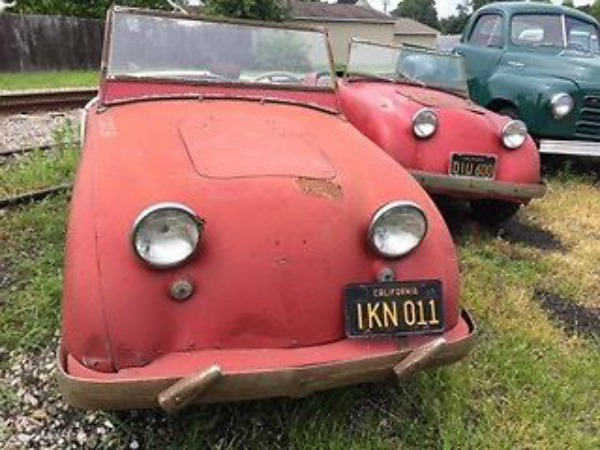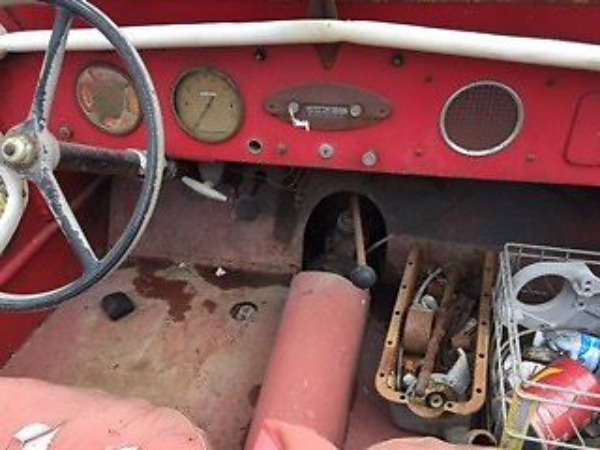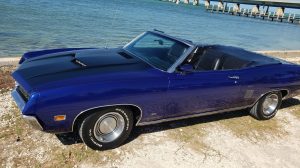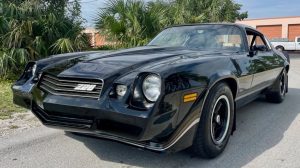Its a shame that more American enthusiasts don’t know the story of the Crosley Hot Shot. Born from the parts and pieces of one of the smallest cars ever made in America, the Hot Shot was arguably our first real sports car. While production ended in 1952, you have to wonder where American sports cars would be today if these little cars benefitted from a continued evolution like we have seen with the Corvette. While I doubt it would have ever been on equal footing with the Corvette, I think that British roadsters such as the Austin Healey Sprite and the Triumph Spitfire might have had an uphill struggle building market share against an evolved Hot Shot. A Crosley Hot Shot won the Index of Performance at the first Sebring race, so they already had a good racing pedigree! This Crosley Hot Shot, which is for some reason advertised as a 1947 model, is for sale on Ebay with a buy it now price of $4500. The owner is also taking offers, just in case you want to travel to Utica, Ohio to purchase this petite milestone car for your collection.
Let’s address the year of production first. Crosley produced the Hot Shot from 1949 through the end of automobile production in 1952. They also produced a very similar car, called the Super Sports, which had doors installed. According to the EBay ad, the vehicle identification number is VC40201, but they list the car as a 1947 with a clear title. When you look at the Identifying Your Crosley page of the Crosley Automobile Club’s website, it states that this VIN number is for a 1952 Hot Shot or Super Sports. While I doubt the owner is trying to deceive anyone, cars with lost titles end up with the titles of junkyard cars all the time. The wrong time to correct any title problems is when the car is in your possession four states away, the money has changed hands, and you are sitting in the title office wondering how to fix the mess. As with any transaction, buyer beware.
When I first saw the pictures of this car, I was horrified that it was left out in the elements. While that might be the case now, there is no way it has been outside for long. I have seen Hot Shots, and many convertibles for that matter, with no floor to speak of after being loved tenderly by Mother Nature. Crosleys were known for rusting, so the absence of major rust here is good news for now. I hope whoever purchases this car gets it under cover soon. The body isn’t in too bad a shape, except for some obvious dings and dents.
Inside, there are a few missing pieces, but I cannot tell if the floor pans are originals because of the low resolution of the photos. They may be sheets of steel welded in, but Crosleys were little more than that in the first place. Hopefully the transmission cover is laying around in the car somewhere, but having the engine components lounging around in an oil pan bathtub isn’t a recipe for success. Maybe they left the drain plug out, so the water has a way to escape. The seats, and the material they are stuffed with, seem to have the original factory seat covers on them. Of course, the stuffing is sucking up water to ensure that the internals are rusting away even when it isn’t raining. Amazingly, it looks like an authentic Crosley radio is still in the dash. Considering that Powell Crosley made his fortune in the radio business, a radio is a must have for any Crosley.
Yes, that is the engine sitting on the passenger seat. It looks to be the later cast iron block that would be correct in the car. Earlier postwar Crosleys had an interesting engine called the CoBra, which stood for copper brazed. The engine components were made of stamped steel that were brazed together using copper and hydrogen. Originally used on generator sets during World War II, Crosley adapted the revolutionary engine for his tiny cars. Use and abuse in automobiles found the weaknesses of this design in short order, and it was replaced by a cast iron unit early in 1949. The cast iron engines lived on for years after Crosley automobile production stopped in 1952. They were used in over the road trailer refrigeration units mostly. Believe it or not, these engines could be hopped up to amazing horsepower levels, with most speed parts made by a guy named Nick Brajevich under the brand name Braje.
It is said that desperate people do desperate things. The sentence that needs to be amended to add that sometimes these desperate things are strokes of genius. The Crosley Hot Shot was built by a company desperate to find a niche in the market, and small enough to exploit it quickly. When you study the car, it is as uniquely American as the MGTC is British in every way. Its a shame that Crosley couldn’t hang on long enough for new models to evolve and better meet the market. They were unique cars with a lot of good features, but little cars just weren’t on the minds of Americans during these economic boom years. Good cars for what they were, this Hot Shot needs a good home quickly. Let’s hope one of you can save it.
















I believe the engines lived on for quite some time as outboard boat engines.
I would rather have the Studebaker truck.
Bennett, you have done your homework. This is a factual, well written piece and should be displayed for your co writers to see. Instead of “I think it should be ……” groundless opinions.
Very, very good!
Have to comment on the title: If this car was bought for racing it did not have to be titled for street use. Often when they went to title these cars (think AC Bristol, Arnolt-Bristol) the dmv would agree with the owner about the year. Race cars did not need to be titled and then when they were the years were often incorrect. No one had the ability to look it up on the internet or easily consult the clubs.
Cars were sold all of the time without a title. Heck they still are. For a race car all you need is the BOS (and a certified statement that it is indeed a race car and not for street use).
Neat little car but far from America’s first sports car. The stutz bearcat came out in 1912 and I don’t think it was even first.
I remember the engines from these being used in the small bore sports racers. They were really quick in time period eventually being replaced by more modern motorcycle engines. I think they were also used in 1/4 midgets but someone with more knowledge than I would have to verify.
Crosley certainly was innovative and given different circumstances I think he would have survived longer, but America was really moving to big cars with chrome when he was trying to build small and efficient.
1/4 midgets are real small. Crosley engines were used in midgets and maybe 3/4 midgets. But, certainly, Powel Crosley is not as well known today as some of the other innovative industrialists, but he should be! My parents’ first clothes dryer was a Crosley and I owned 2 Crosley cars – but this Hot Shot does not speak to me. I hope somebody with more enthusiasm will take it on!
I believe thsee cars were part of the ron hackenburger collection sold last month. All the crosleys were basket cases. I’ve seen several cars from this sale up for sale at 2 times the auction prices.
Hey Brian! Hope you’re not shopping eBay late at night.
Great write up jeff… i must find one of these super chargers gor mine
This could be a lot of fun as the cheapest way into vintage racing. Were I not deep into other car projects, I’d be circling this one in hopes of snatching it with an offer. It reminds me of the Deutsch Bonnet HBR5 that I almost bought off a guys front lawn, with same idea of tiny car vintage racing. I’ll probably regret not buying this one, too!
That ‘s a tough one. Deutsch Bonnet vs a Crosley Hot Shot. Weak fiberglass vs rust.
Hey Brian. I don’t know what he paid for it but I bought a car from this seller this morning and could not be more pleased with the price and the transaction. When I was 3 maybe 4 my dad took me to the new car show in Indianapolis and let me go for a test ride in one of the several Hot Shots or Super Sports. Cold, windy, noisy, smell of pollutants. It’s the first time I felt fear by myself. Probably why I still partake in the hobby today.
If it makes you happy,then the price you paid is just right. I was at the Hackenburger auction, and bought 1 car there. I really like it,and I’m not going to flip it. ENJOY
That debate has been ongoing for years, what was the 1st US sports car? While, the Hot Shot had all the qualifications for a sports car, I think people thought more of them as a toy, and the Nash-Healey was the 1st true American sports car ( and even that is disputed as the 1st N-H’s were made in England)
Just the wrong timing, and had this come out in the 70’s, when people were turning to small cars, it woud have been a hit, but in the 50’s, people were doing just the opposite, going bigger and faster. Not sure what to do with this, as it’s just as out of place on today’s roads as it was in the 50’s. I hope the RR doesn’t decide to use that siding for something,,,
My candidate for the first American sports car would be the American Underslung of 1905. It was developed by Harry Stutz and designed for superior handling. In fact, the whole underslung thing was revolutionary and expensive. Same basic engineering as used on the step down Hudsons about 40 years later. https://en.wikipedia.org/wiki/American_Underslung
The 1st Deustche Bonnet I ever saw was in the early 1960’s, and in Ohio. It was a Deutsche Bonnet Lemans Coupe, which is a poetic name. Looked fast, and had cast wheels with integral brake drums. Power was a 750 or so CC Panhard 2 cylinder. I believe an example also won an index of performance.
The Underslung had the frame positioned below the front and rear axles. Not so on the Hudson which had IFS and the rear end was below the frame as was conventional. Engineering was not very similar
And they had 40 inch wheels to counteract the very low slung frame. Because when they set off for an endurance race it wasn’t on paved highways. Sometimes they were navigating on nothing more than a cow path.
We have one at the Simeone Museum. It starts our collection of competition cars.
http://www.simeonemuseum.org/the-collection/endurance-trial/1909-american-underslung-traveler
You mentioned that the Hot Shot won the first Sebring race, but if I recall correctly, the driver was Road and Track scribe Henry N Manney III. How many are old enough to remember reading his wonderful prose in R&T?